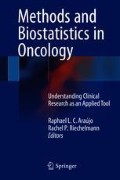Abstract
Sample size calculation is at the core of study design. It is defined as the calculation of the minimum number of subjects to be included in a study in order to detect a true effect or value and must always to be performed a priori. Several aspects have to be considered when computing a sample size, including assumptions of expected outcomes in the control and experimental groups, type I and II error rates, power, and the dropout rate. Without proper sample size calculation, the results of a clinical study can be misleading, not generalizable to other settings, more likely to be false negative or false positive, and might even be associated with ethical implications. Additionally, careful planning and accurate reporting of this calculation ensures transparency and reliability and allows the reproducibility of results.
Access this chapter
Tax calculation will be finalised at checkout
Purchases are for personal use only
References
Clark TG, Bradburn MJ, Love SB, et al. Survival analysis part I: basic concepts and first analyses. Br J Cancer. 2003;89:232–8.
Guller U, Oertli D. Sample size matters: a guide for surgeons. World J Surg. 2005;29(5):601.
Dubey SD. Some thoughts on the one-sided and two-sided tests. J Biopharm Stat. 1991;1:139–50.
Bariani GM, de Celis Ferrari AC, Precivale M, et al. Sample size calculation in oncology trials: quality of reporting and implications for clinical cancer research. Am J Clin Oncol. 2015;38:570–4.
Fleming TR. One-sample multiple testing procedure for phase II clinical trials. Biometrics. 1982;38:143–51.
Gehan EA. The determination of the number of patients required in a preliminary and a follow-up trial of a new chemotherapeutic agent. J Chronic Dis. 1961;13:346–53.
Simon R. Optimal two-stage designs for phase II clinical trials. Control Clin Trials. 1989;10:1–10.
Saad ED, Sasse EC, Borghesi G, et al. Formal statistical testing and inference in randomized phase II trials in medical oncology. Am J Clin Oncol. 2013;36:143–5.
Simon R, Wittes RE, Ellenberg SS. Randomized phase II clinical trials. Cancer Treat Rep. 1985;69:1375–81.
Waddell T, Chau I, Cunningham D, et al. Epirubicin, oxaliplatin, and capecitabine with or without panitumumab for patients with previously untreated advanced oesophagogastric cancer (REAL3): a randomised, open-label phase 3 trial. Lancet Oncol. 2013;14:481–9.
Riechelmann RP, Alex A, Cruz L, et al. Non-inferiority cancer clinical trials: scope and purposes underlying their design. Ann Oncol. 2013;24(7):1942.
Walker E, Nowacki AS. Understanding equivalence and noninferiority testing. J Gen Intern Med. 2011;26:192–6.
Montgomery AA, Peters TJ, Little P. Design, analysis and presentation of factorial randomised controlled trials. BMC Med Res Methodol. 2003;3:26.
Green S, Liu PY, O’Sullivan J. Factorial design considerations. J Clin Oncol. 2002;20:3424–30.
Bosset JF, Collette L, Calais G, et al. Chemotherapy with preoperative radiotherapy in rectal cancer. N Engl J Med. 2006;355:1114–23.
Cunningham D, Starling N, Rao S, et al. Capecitabine and oxaliplatin for advanced esophagogastric cancer. N Engl J Med. 2008;358:36–46.
Kernan WN, Viscoli CM, Makuch RW, et al. Stratified randomization for clinical trials. J Clin Epidemiol. 1999;52:19–26.
Mayer RJ, Van Cutsem E, Falcone A, et al. Randomized trial of TAS-102 for refractory metastatic colorectal cancer. N Engl J Med. 2015;372:1909–19.
Green SJ, Fleming TR, O’Fallon JR. Policies for study monitoring and interim reporting of results. J Clin Oncol. 1987;5:1477–84.
Posch M, Bauer P, Brannath W. Issues in designing flexible trials. Stat Med. 2003;22:953–69.
Arya R, Antonisamy B, Kumar S. Sample size estimation in prevalence studies. Indian J Pediatr. 2012;79:1482–8.
Halpern SD, Karlawish JH, Berlin JA. The continuing unethical conduct of underpowered clinical trials. JAMA. 2002;288:358–62.
Altman DG. Statistics and ethics in medical research: III How large a sample? Br Med J. 1980;281:1336–8.
Schulz KF, Altman DG, Moher D, et al. CONSORT 2010 Statement: updated guidelines for reporting parallel group randomized trials. Open Med. 2010;4:e60–8.
Author information
Authors and Affiliations
Editor information
Editors and Affiliations
Rights and permissions
Copyright information
© 2018 Springer International Publishing AG, part of Springer Nature
About this chapter
Cite this chapter
Riechelmann, R.P., Araújo, R.L.C., Haaland, B. (2018). Sample Size Calculation in Oncology Studies. In: Araújo, R., Riechelmann, R. (eds) Methods and Biostatistics in Oncology. Springer, Cham. https://doi.org/10.1007/978-3-319-71324-3_5
Download citation
DOI: https://doi.org/10.1007/978-3-319-71324-3_5
Published:
Publisher Name: Springer, Cham
Print ISBN: 978-3-319-71323-6
Online ISBN: 978-3-319-71324-3
eBook Packages: MedicineMedicine (R0)

